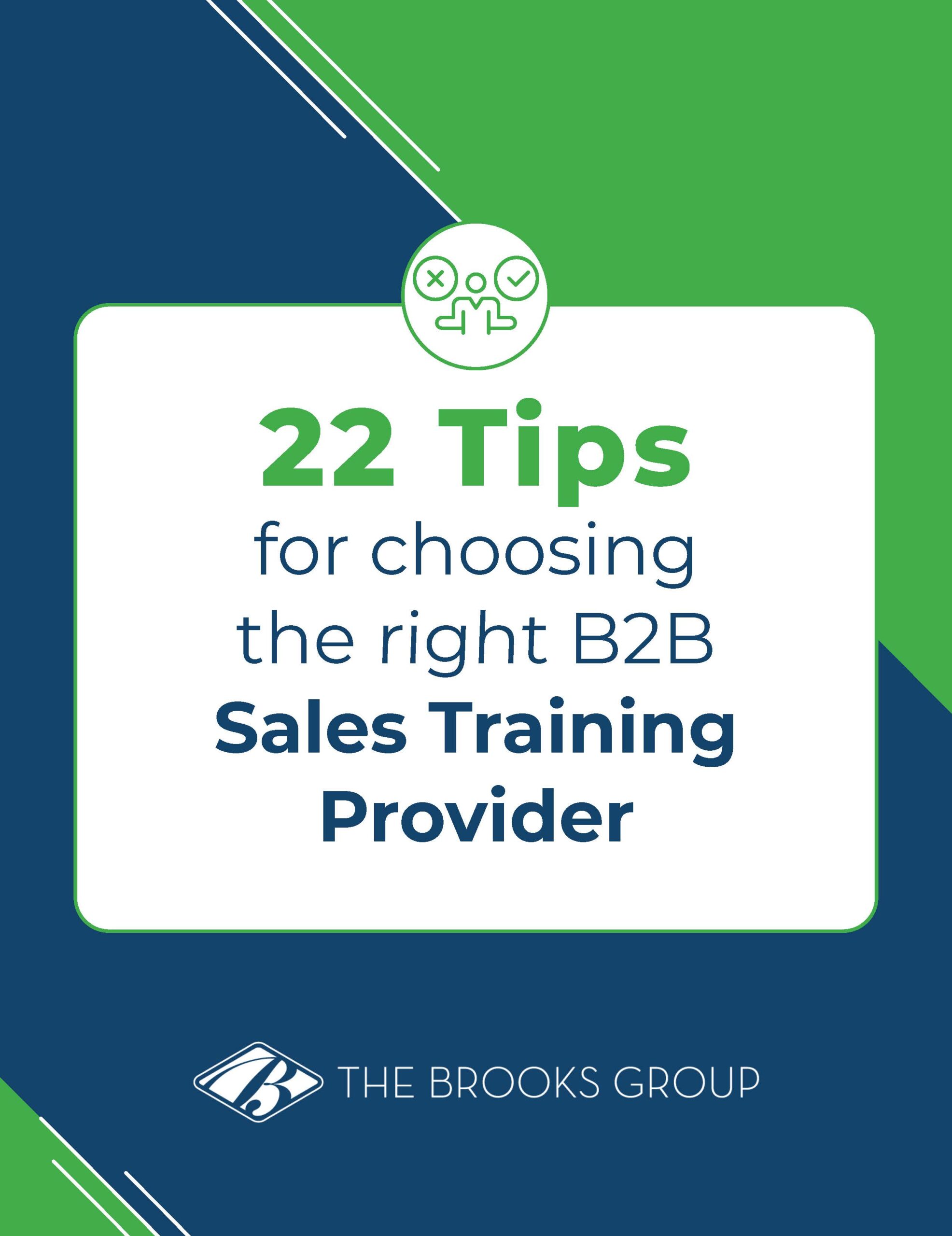You know you should measure sales training ROI. But you wonder if it’s really important. Isn’t the main thing just to get the training done?
Yes and no. Step one, you need to train your sales team. But step two should be making sure your training is getting the results you want. You can only know if training contributes to the bottom line when you measure the before-and-after impact.
Sales Training Improves Your Bottom Line
By investing in sales training and developing an effective sales force, organizations can drive revenue growth, improve customer relationships, and gain a competitive advantage—ultimately contributing to a stronger bottom line. Here are eight ways effective sales training makes a difference.
Improved Sales Skills
Sales training programs focus on developing essential skills such as prospecting, qualifying leads, objection handling, negotiation, and closing techniques. These enhanced skills enable sales professionals to navigate the sales process more effectively and convert more prospects into customers.
Sales Process Adherence
Sales training helps standardize and reinforce best practices and sales methodologies across the organization. Consistent sales process adherence reduces variability in sales performance and ensures proven techniques are applied consistently.
Increased Sales Productivity
Well-trained sales professionals are more efficient and effective in their sales approach, which can lead to higher sales volumes and shorter time to close. This improved sales productivity directly translates into higher revenue generation.
Increased Cross-Selling and Upselling
Sales training programs often cover techniques for identifying additional customer needs and offering complementary products or services. This can lead to higher average order values and increased revenue from existing customers.
Better Customer Engagement
Sales training equips sales professionals with effective communication skills, product knowledge, and consultative selling techniques. This improves their ability to engage with customers, understand their needs, and provide tailored solutions, leading to higher customer satisfaction and retention.
Competitive Advantage
By investing in sales training, organizations can differentiate themselves from competitors and position their sales force as knowledgeable, skilled, and buyer focused. This can lead to a competitive edge in the market and improved customer loyalty.
Reduced Sales Rep Turnover
Sales training can increase job satisfaction and retention rates by providing sales professionals with the necessary skills and knowledge to succeed in their roles. This reduces the costs associated with hiring and training new salespeople.
Improved Brand Reputation
A well-trained and professional sales team can positively impact the brand’s reputation by delivering consistent and high-quality customer experiences, which can ultimately lead to increased customer loyalty, referrals, and revenue growth.
Sales Training ROI Helps Prove Value
Measuring sales training effectiveness is crucial for several reasons. When you can connect the cost of training with your business outcomes, you’ll know the return on your investment (ROI).
This helps you make informed decisions, allocate resources effectively, and ensure your training efforts are contributing to the overall success and profitability of the business.
Justify Your Investment
Sales training programs can be expensive, and measuring the ROI helps justify the cost by demonstrating the tangible benefits and revenue generated from the investment.
Evaluate Effectiveness
By calculating the ROI, you can evaluate the effectiveness of the sales training program. If the ROI is positive and significant, it indicates the training was successful in improving sales performance and revenue generation.
Identify Areas for Improvement
If the ROI is lower than expected, it can help identify areas where the training program needs improvement or modifications to better align with the desired outcomes.
Make Data-Driven Decisions
Measuring ROI provides quantitative data that can inform future decisions about whether to continue, modify, or discontinue the sales training program. It allows for data-driven decision-making rather than reliance on solely subjective assessments.
Maximize Resource Allocation
By understanding the ROI of sales training, organizations can optimize their resource allocation and prioritize investments that yield the highest returns.
Demonstrate Value to Stakeholders
A positive ROI for sales training can help demonstrate the value of the program to stakeholders such as executives, investors, or board members, and help secure continued support and funding.
Benchmark and Compare
ROI calculations can be used to benchmark the performance of different sales training programs or compare the effectiveness of various training approaches or vendors.
Sales ROI Proves Sales Proficiency
It’s crucial to assess the sales team’s skills and knowledge both before and after training. This allows you to quantify the improvements achieved and directly attribute them to your training investment.
By comparing pre-training and post-training sales performance metrics such as average sale amount, conversion rate, sales velocity, customer satisfaction, and productivity, you can accurately measure the impact of the training on skill development.
This data not only justifies the training investment but also provides insights into the specific areas where sales professionals have made the most significant progress, enabling targeted reinforcement or additional training as needed.
Regularly evaluating and comparing sales skills before and after training ensures the program is delivering tangible results and enables organizations to continually refine and optimize their training efforts for maximum effectiveness and ROI.
How to Calculate ROI of Sales Training: 10 Steps
Here are ten steps to measure the ROI of your sales training investment and its overall effectiveness.
1. Assess Selling Skills
Measuring skill improvement through pre- and post-training sales assessments is an essential step in understanding the direct benefits of sales training and making data-driven decisions about future training initiatives.
See how The Brooks Group Selling Skills Index® helps measure and improve sales professionals’ fundamental selling skills.
2. Establish Baseline Metrics
Before conducting the training, collect data on key performance indicators (KPIs) such as average sales cycle length, win rate, average deal size, and overall revenue. This will serve as the baseline for comparison.
3. Define Objectives and Targets
Set clear and measurable objectives for the sales training program, such as increasing win rates by a certain percentage, reducing sales cycle time, or increasing average deal size. These targets will help determine the expected return.
4. Calculate Training Costs
Determine the total cost of the sales training program, including expenses like trainer fees, materials, facilities, and travel costs for attendees.
5. Measure Post-Training Performance
After the training, continue to track the same sales KPIs over a defined period (e.g., 3-6 months). Compare the post-training metrics to the baseline to quantify improvements.
6. Calculate Increased Revenue
Based on the improvements in sales metrics such as win rate, deal size, and sales cycle time, calculate the additional revenue generated by the trained sales force over the same period.
7. Determine the Net Profit
Subtract the total training costs from the increased revenue to find the net profit or return generated by the training investment.
8. Calculate ROI Percentage
Divide the net profit by the total training costs, and multiply by 100 to get the ROI percentage. A positive ROI indicates the training provided a positive return.
9. Consider Intangible Benefits
While calculating the ROI, also factor in any intangible benefits such as improved customer satisfaction, employee retention, or competitive advantage, which can indirectly impact revenue.
10. Continuously Monitor and Adjust
Regularly review your ROI calculations and make adjustments based on changing market conditions, sales strategies, or additional training needs.
Choose the Right Sales Training Provider
It’s important to note that calculating ROI for sales training can be complex, as it involves isolating the impact of the training from other factors influencing sales performance. Involving stakeholders, setting clear goals, and using consistent measurement methods can help ensure an accurate ROI assessment.
The right sales training provider will help you calculate the ROI of training with pre- and post-training assessments, metrics at key milestones, and performance measurements to track team knowledge, application, and results.
See how The Brooks Group IMPACT Selling® training program improves sales professionals’ fundamental selling skills and generates proven ROI.
White Paper Download
22 Tips for Choosing the Right B2B Sales Training Provider
Choosing a sales training provider is one of the most important business decisions you’ll ever make. But with so many confusing choices, finding the right partner can be overwhelming. Download this white paper for 22 tips to help remove the uncertainty and give you greater confidence in your decision.





